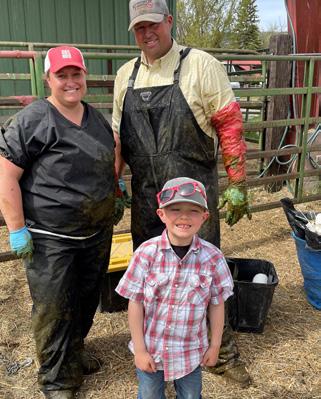
4 minute read
Cattle Genetics and Raising an Ag-Savvy Son




WRITTEN BY REBECCA COLNAR | PHOTOS COURTESY THE SUTHERLIN FAMILY
Lacey Sutherlin didn’t grow up in agriculture in Stevensville, Montana. Her father was a teacher and her mother is involved in sales and administrative work; however, her uncles had ranches, so Lacey spent plenty of time learning about cattle while growing up. In high school, she worked for a local Angus breeder, which is where she got her cattle “bug.” She and her future husband, Chad, were friends in high school and she spent plenty of time on his family’s ranch.
After college, Lacey accepted a job with ORIgen, a cattle genetics company, where she discovered her fascination with cattle breeding. Lacey is currently a District Sales Manager for ABS Global. She manages 22 representatives throughout Montana, Wyoming, Idaho and Washington. She loves cattle genetics, noting it is essentially the art of matching cattle pedigrees together to make matings that yield better cattle. “Creating matings is a science with the end product being a safe, tasty, juicy, healthy protein for consumers to feed their families.”
Her 6-year-old son, Cayden, has already developed the cattle bug. “He’s in Kindergarten and is known as the rancher in the class. He explains tractors and anything cow-related to the other students. We took a baby calf to his class, and his classmates took turns bottle feeding and learning about caring for an animal.
I think it’s important for kids to learn about animal husbandry, developing a work ethic and learning the responsibility of taking care of a young animal. There were some children who had never seen a baby calf.”
They answered questions in ways the students could relate to: “Where does he live?” “We give him shelter and he has a little field to run and play.” “What does he eat?” “Calves drink milk and he gets a bottle every 12 hours so he doesn’t get hungry.”
“We explained that our animals come first. They usually get fed before we do, and if there’s a storm, we’re out there ensuring those animals have some kind of shelter,” said Lacey. “On Valentine’s Day we took our liquid nitrogen (that’s used in our breeding services, so we always have some around) to make liquid ice cream, similar to how Dippin’ Dots uses cryogenic technology. We stirred up the cream and sugar with the kids. It was a great way to teach them about milk and dairy products.”
Cayden wants to be rancher like his dad. He’s a good worker and enjoys helping, such as moving cattle up the alley from the outside. He owns a couple of real cows that have their unique ear tag color. The enterprising youngster even has a “500-head ranch” in the Sutherlin’s living room covered with cattle handling equipment, alleys and sorting tubs.
Lacey and Chad enjoy that both of their jobs allow them to bring their son with them. “Ever since Cayden was born, he has come to work with me, even if he was in a backpack. My customers and sales reps have gotten to know him, and he’s sociable and converses easily with adults. He also spends time with his dad, whether they’re calving or haying.”
Lacey believes it’s important that kids have a job to do. No matter what you do, she says parents should take their children to work and make them part of your life. Give them a small job to do while they are with you, whether it’s doing a little clean up or labeling something.
The young woman adds that people farm and ranch because it’s a lifestyle they enjoy. She notes that it’s not a way to get rich, but it’s a great environment for raising children. “They learn about having a good work ethic, food safety and responsibility. We are out with our animals 365 days each year. The success for us is seeing the younger generation taking on farming and ranching. As easy as it might sound, we can’t feed this country out of a petri dish.”
Lacey encourages parents not involved in agriculture to ask to visit a local farm or ranch with their children, and learn about what it takes to put food on the table.
Rebecca Colnar is Director of Public Relations for Montana Farm Bureau and a freelance writer from Custer, Montana.








